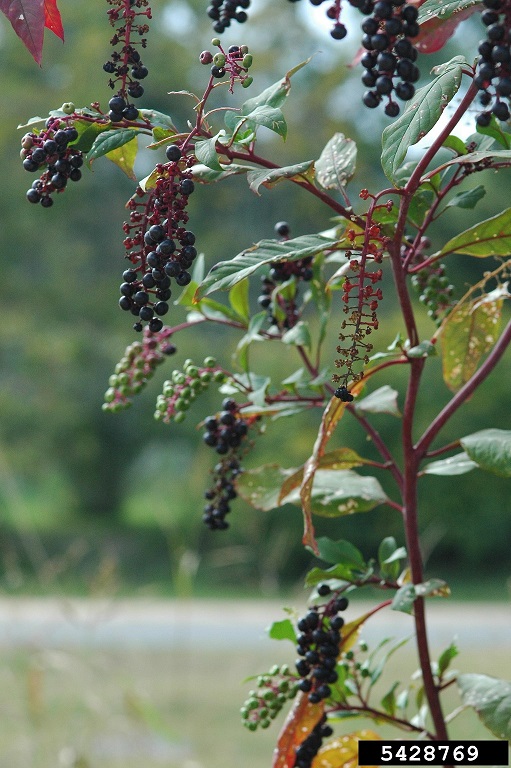Difference between revisions of "Phytolacca americana"
(→Ecology) |
|||
| Line 55: | Line 55: | ||
<!--===Diseases and parasites===--> | <!--===Diseases and parasites===--> | ||
| − | ==Conservation and | + | ==Conservation, cultivation, and restoration== |
| − | == | + | ==Cultural use== |
==Photo Gallery== | ==Photo Gallery== | ||
<gallery widths=180px> | <gallery widths=180px> | ||
Revision as of 18:18, 8 June 2021
| Phytolacca americana | |
|---|---|

| |
| Photo by Karan A. Rawlins, University of Georgia, Bugwood.org | |
| Scientific classification | |
| Kingdom: | Plantae |
| Division: | Magnoliophyta - Flowering plants |
| Class: | Magnoliopsida – Dicotyledons |
| Order: | Caryophyllales |
| Family: | Phytolaccaceae |
| Genus: | Phytolacca |
| Species: | P. americana |
| Binomial name | |
| Phytolacca americana L. | |

| |
| Natural range of Phytolacca americana from USDA NRCS Plants Database. | |
Common names: American pokeweed; Common pokeweed; Poke; Pokeberry[1]
Contents
Taxonomic notes
Synonyms: none.[1]
Description
A description of Phytolacca americana is provided in The Flora of North America. It is a robust, perennial herb that grows 1-3 m tall. The roots are thick and fleshy. The leaves have an alternate pattern, glabrous texture, entire margin, and lanceolate to elliptic shape. They grow 3-12 cm wide and 8-30 cm long with a rounded base. The petioles are 1-5 cm long. Racemes are 5-20 cm with bracteate pedicels. The flowers are perfect, colored green to white, and 2-3 mm long. They include 5 sepals, 5-30 stamens, and a superior ovary. The berries are 5-12 carpellate, purplish-black, 4-6 mm long, and 7-10 mm in diameter. The seeds are lustrous black, 2.5-3 mm long, and flattened.[1]
Distribution
This plant is an abundant native weed that occurs throughout eastern North America.[1]
Ecology
Habitat
P. americana has been found in hydric hammocks, swamp edges, coral limestone, sandbars, mangrove swamps, and floodplain forests.[2] It is also found in disturbed areas including disturbed coastal hammocks, along canals, farmlands, orange groves, landfills, burned longleaf pine-wiregrass flatwoods, pine-hickory camping woods, and along roadsides.[2] Associated species: Sabal, Quercus, Elaphrium, Swietenia, Dalbergia, Gouania, and Schinus.[2]
Phenology
This plant has been observed to flower from March through November, with peak inflorescence in May through July.[1][3]
Pollination
The following Hymenoptera families and species were observed visiting flowers of Phytolacca americana at Archbold Biological Station:[4]
Apidae: Bombus impatiens
Halictidae: Augochlora pura, Augochlorella striata, Augochloropsis metallica, A. sumptuosa, Lasioglossum lepidii, L. miniatulus, L. nymphalis, L. pectoralis, L. placidensis, L. puteulanum
Megachilidae: Heriades leavitti
Sphecidae: Ectemnius maculosus, E. rufipes ais, Isodontia exornata, Oxybelus laetus fulvipes
Vespidae: Leptochilus alcolhuus, L. republicanus, Polistes dorsalis hunteri, Zethus slossonae
Conservation, cultivation, and restoration
Cultural use
Photo Gallery
References and notes
- ↑ 1.0 1.1 1.2 1.3 1.4 1.5 1.6 Weakley, A.S. 2015. Flora of the southern and mid-atlantic states. Working Draft of 21 May 2015. University of North Carolina at Chapel Hill, Chapel Hill, North Carolina.
- ↑ 2.0 2.1 2.2 Florida State University Herbarium Database. URL: http://herbarium.bio.fsu.edu. Last accessed: June 2021. Collectors: Loran C. Anderson, George R. Cooley, R. J. Eaton, D. L. Fichtner, Robert K. Godfrey, B. K. Holst, O. Lakela, S. W. Leonard, Marc Minno, Grady W. Reinert, Cecil R Slaughter, S. D. Todd, and Jean W. Wooten. States and counties: Florida: Hernando, Indian River, Jefferson, Leon, Liberty, Manatee, Monroe, Okaloosa, Orange, and Sarasota.
- ↑ Nelson, G. PanFlora: Plant data for the eastern United States with emphasis on the Southeastern Coastal Plains, Florida, and the Florida Panhandle. www.gilnelson.com/PanFlora/ Accessed: 19 MAY 2021
- ↑ Deyrup, M.A. and N.D. 2015. Database of observations of Hymenoptera visitations to flowers of plants on Archbold Biological Station, Florida, USA.